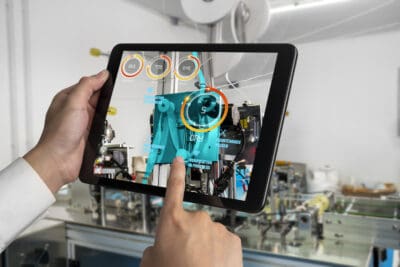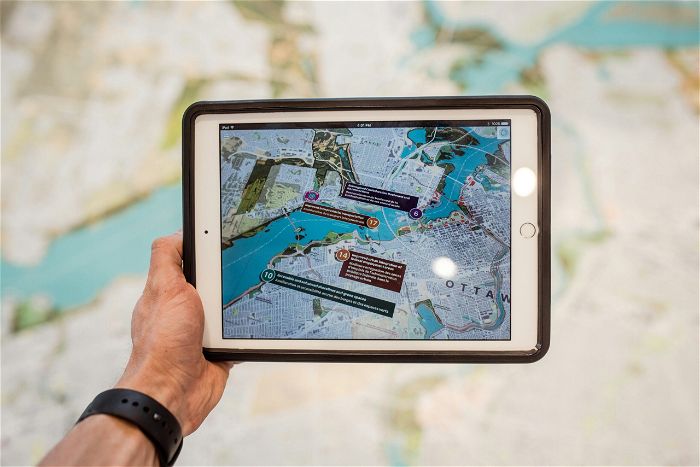How did you hear about the AR program? Why did you decide to participate?
Chaney: I was initially looking for a trucking program [with Mott’s Workforce and Economic Development Center]. When I got there and heard about AR, that sparked my interest, as I had an idea to start my own location-based app with elements similar to Pokémon Go. When I heard [Mott instructor] Kyle Williams say this program would help me with that goal, I thought there might be something here.
Ever since I was a kid, I always had a strong imagination. I always wanted to bring my drawings and other things I built to life. And I wanted to share that imagination with other people to bring light into their lives.
Moe: In my work, I oversee the IT Business collaborative of tech employers. When [SKCTC AR program champion Sandra Brown] reached out [to discuss the AR pilot], I tapped a couple of our tech employers to see if they wanted to fill any seats.
[Regarding my own participation] I’ve taken advantage of a lot of the courses I come across in this work. I enjoy learning and staying up to date. I did think this AR programming was interesting . . . I also thought it would be good to get an inside look, so if this is offered again in the future, I could present it well to employer partners.
Aybar: A former UX design professor referred me to the program through email. The poster the program used in their message was super exciting. The fact that they mentioned Meta was interesting, as I didn’t know they had an AR platform. Also, I knew Kingsborough had great programs for CUNY students. The poster said it would be an in-person program, and I was eager to meet my cohort.
My curiosity led me to apply. I’ve always thought of UX as simply working on prototyping apps and websites and researching users for those platforms. I never really thought of UX being used in other ways, like with AR. I had to be open-minded, which is important in the UX field in general, as you have to work with users from different backgrounds.
What supports are necessary for learners in an AR training program?
Chaney: [This program] was easily accessible—it was free and not out of pocket. [The staff] reached out and showed how they cared [during recruitment]. I even brought my dad in [to one of Mott’s informational sessions] to hear about the programming. Continuing to have that community-based involvement to bring people in [is important].
Moe: When I take courses, I like when I can do them self-paced, online. Sometimes I might spend seven hours working on training, but then it might be several days before I can come back to it. If I would’ve had to sign up for a scheduled in-person AR class, I would not have been able to do it with my full-time work.
Aybar: A great instructor is really important. [The Kingsborough instructor] encouraged us to stay curious and bring in our expertise. He wanted us to use our knowledge from UX and graphic design, as well as psychology, sociology, and other majors from the cohort. It helped us discover how AR can be applied in different ways. He was also helpful when it came to feedback; it was always very constructive, which helped our projects grow a lot.
What was challenging about the programming?
Chaney: Some of the coding was challenging, but the fun part was when we came together as a team, ironed out the wrinkles, and jumped over those boundaries. Once we put the puzzle pieces together, we realized how you can connect AR to so many things. It was fun to see how far AR can go. You have to be motivated by the challenges or it’ll be easy to quit. The challenges brought [the cohort] together. Having a small class helped with that.
Moe: The timeline [six weeks] was a challenge. Getting started with the platform itself [downloading it on a phone and a laptop] was also a challenge. I should’ve had all of that taken care of ahead of day one so that I could’ve dived in on the first class. But once we got it all figured out, the instructor did a good job of getting us through the material.
Aybar: I had some challenges with the platform. I took an AR class a few semesters ago at Hunter, which used a very different [AR product creation] platform. But Kingsborough’s instructor was there to help us every step of the way; the tutorial videos were also helpful.
Additionally, my other AR class had nothing to do with implementing UX principles; it was more of an art class. I had to break away from the “using AR purely as art” mindset, which was difficult. But as someone who wants to be a UX designer, I had to focus on the users and what could help them.
How might colleges market AR training and get learners interested?
Chaney: To help bring in learners, have people come in [from the local community] to see the different applications of AR like we did with Mott’s AR GameJam event [where learners demonstrated their AR projects] to show what augmented reality can do. [Showing use cases] helps people use their imaginations . . . uses in health care, construction, and so on.
Moe: It’s very important for learners to see different use cases of AR. At the Chamber of Commerce, with the employers I work with, when somebody does a standout project, we write up a case study so that other talent pipeline managers throughout the U.S. can see. [Having the student AR projects from SKCTC’s first program] reinforces to other learners that the training does work.
I would also like to share this opportunity with other colleges in the Kentucky community college system for their cybersecurity programs. They could use AR to develop some of their promotional materials, which would help gamify opportunities and give them a simple and fun way to attract students.
Aybar: [When promoting AR training to UX students] colleges need to make a clear connection between UX and AR in the marketing materials and highlight the fact that students will create projects for their portfolios, as that’s something all UX students need.
How might AR improve people’s lives?
Chaney: [I have an idea for incorporating] AR exercises into the free coupons that you get every Saturday and Sunday in the mail, but for healthy foods, to motivate people to have a healthier lifestyle.
Moe: For smaller companies that can’t afford a lot of different staff positions, these skills are great for marketing. If they have someone in their organization use AR to make compelling ads, that’s a huge advantage. Also, I work with a large manufacturing organization and there is so much technology embedded in the work. Finding enough workers for manufacturing has become difficult, and being able to automate tasks is essential. Soon, the Chamber is hosting an AI conference, and I feel AR will come behind that, as they’re both necessary.
Can you describe your final project?
Aybar: Sustainability is something I’m really passionate about. I wanted my project [on sustainable shopping] to help people who are interested in sustainability but maybe never practiced it before. I didn’t want to create something just for experts.
I work part time at a store that sells cards and trinkets. I saw a plush toy there, and it said on the tag it was made sustainably, which triggered my idea. With my project, the user can use their phone camera to scan an item’s bar code, preferably an item made out of cloth [demoed with a plush toy], and it displays all of the sustainability information. For example, you’ll see how much water was used to make a product, as well as the carbon emissions it took to create it and ship it out, in addition to its longevity. Users can then make an informed decision to invest in a sustainably made product.
Our instructor included a “tech for good” element in the prompt for our final projects, which was a key piece of me coming up with the idea.
What advice would you give to other people interested in AR?
Chaney: Almost everything you go into without a lot of knowledge—you have that sense of nervousness: Are you going to fail? But because I saw a connection [between the programming and my ideas], I said, I’m going to step into this door and see what it’s about. Keep your mind open; don’t be scared. There’s going to be challenges and hills to climb. [AR] is going to be the future down the road. Definitely get ahead of the curve, absorb all the knowledge you can, and have fun with it. Because it is fun!
Most of the students in the program were around the same age, late 30s. I would love my daughter to get into this. She wants to start her own clothing line and wants to bring her ideas to life. I showed her the [Meta Spark platform].
Aybar: Don’t be afraid to seek guidance—asking questions helped me develop a deeper understanding of AR and UX’s connection to it. My questions also ended up helping colleagues of mine, as they often had the same thoughts.
And it’s OK to be nervous. You can have that initial worry of, “Will I understand the program and make something people can use?” But because of this course, in the future, if I work for a company that wants to implement AR, I have a real leg up. For students who are hesitant, if you have the time and resources to join, go for it!






